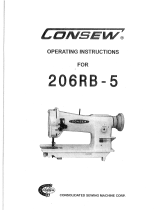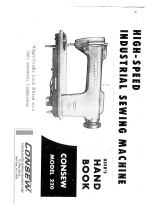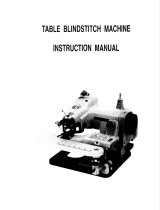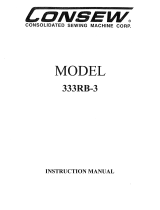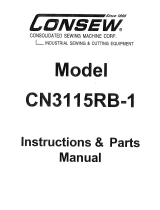Page is loading ...


1}
1
INDEX
CONTENTS
I
Page
Setting up the machine. . . . . . . . . . . . . . . . . . . . . . . . . . . . . . . . . . . . . . .. 2
Breaking-in & Direction of rotation. . . . . . . . . . . . . . . . . . . . . . . . . . . . . .. 2
Oiling
. . . . . . . . . . . . . . . . . . . . . . . . . . . . . . . . . . . . . . . . . . . . . . . . . . . .. 3
Needle. . . . . . . . . . . . . . . . . . . . . . . . . . . . . . . . . . . . . . . . . . . . . . . . . . . .. 5
Thread. . . . . . . . . . . . . . . . . . . . . . . . . . . . . . . . . . . . . . . . . . . . . . . . . . . .. 5
Winding the lower thread on the bobbin. . . . . . . . . . . . . . . . . . . . . . . . . .. 6
Adjustment of the bobbin winder 6
Removing and inserting the bobbin. . . . . . . . . . . . . . . . . . . . . . . . . . . . .'.. 7
Threading the machine
. . . . . . . . . . . . . . . . . . . . . . . . . . . . . . . . . . . . . . .. 8
Regulating the thread tensions
. . . . . . . . . . . .. . .. . . . . . . . . . . .. '.' . . .. 9
Adjusting the lift of the alternating presser feet . . . . . . . .. .. .. . . . . . . .. 10
How to re-set the safety clutch mechanism. . . . . . . . . . . . . . .. . . . . . . . .. 10
Extra slotted needleplate. . . . . . . . . . . . . . . . . . . . . . . . . . . . . . . . . . . . .. 10
INFORMATION FOR ADJUSTMENT
Adjusting the qeight of the feed dog. . . . . . . . . . . . . . . . . . . . . . . . . . . . ..
11
Relative position of the feeder to needle plate
. . . . . . . . . . . . .. .. . . . . .. 11
The position of the needle and the needle hole of the feeder .. .. . .. .. " 12
Timing the needle with feed dog. . . . . . . . . . . . . . . . . . . . . .. . . . . . . . . .. 13
Adjusting the height of the needle bar. . . . . . . . . . . . . . . . .. . . . . . . . . . .. 14
Timing between the hook and the needle .. .. .. .... . .. . .. .. .. .. .... 14
Adjustment of bobbin case opener. . . . . . . . . . . . . . . . . . . . . . . . . . . . . .. 15
Adjusting the height of the presser feet. . . . . . . . . . . . . . . . . . . . . . . . . . .. 16
Timing of the vibrating presser foot . . . . . . . . . . . . . . . . . . . . . . . . . . . . .. 16
Adjustment of the clearance between feed forked
connection and feed fork collar. . . . . . . . . . . . . . . . . . . . . . . . . . . . . . .. 17
Adjusting the thread controller spring. . . . . . . . . . . . . . . . . . . . . . . . . . . .. 18
Adjustment of spring tension of safety clutch. . . . . . . . . . . . . . . . . . . . . .. 19
Supplementary information on oiling. . . . . . . . . . . . . . . . . . . . . . . . . . . . . 20

2
SETTING UP THE MACHINE (Fig. 1)
Before setting up the machine on the table, attach the relative parts to the table.
(1) Stand and treadle (2) Motor (3)Oil pan (4) Hinge
(5) Machine head (6) Knee lifter (7) V belt
(8) Bobbin winder (9) Cotton stand (10)Prop
Fig. 1
BREAKING-IN & DIRECTION OF ROTATION
To assure durability and trouble-free operation, it is imperative that for the
first several weeks of operation the maximum speed is held to no more than
2000RPM in order to allow the parts to become properly broken in.
In operation the handwheel of the machine always turns toward the operator.
To avoid tangled threads and jamming of the sewing hook, do not turn hand-
wheel otherwise.
SPEED
Maximum operating speed after a break-in period is 2400 stitches per minute
depending, of course, on the type of material being sewn, its thickness and that
of the seams being crossed.

3
OILING
Do not operate the machine, even if only for testing, unless it has been properly
oiled at every spot requiring lubrication.
The arrows on the following illustration indicate these spots.
(Fig. 2 - Fig. 6)
NOTE: During the breaking-in period a new machine should be oiled more fre-
quently.
fig. 2
Fig. 3
t(Without Alphabet) marked for Oiling points only.

4
Fig.4
Rg.5 Rg.6
t (WithoutAlphabet)markedfor Oilingpoints only.

5
NEEDLE(Fig. 7)
. I
I
CONSEW 206RB is set up to use standard style DPx17. The size of the needle
to be used should be determined by the size of the thread, which must pass free-
ly through the eye of the needle.
HOWTO ATTACHTHE NEEDLE
1. Turn the machine pulley over toward you until the needle bar<!)moves up to
its highest point.
2. Loosen the needle set screw@ and put the needle@ up into the needle bar
as deeply as it will go, with the long groove of the needle faces the left.
3. Tighten the needle set screw securely.
. I
i
I
I
I
Fig. 7
TEREAD
Cotton, synthetic or silk thread can be used according to your purpose.
* Alwaysuse left twistedthread for upper(needle)thread, but you can use
either right or left twisted thread for lower (bobbin) thread_

6
WINDING THE LOWERTHREAD ON THE BOBBIN (Fig. 8)
1. Push a bobbin on the bobbin winder spindle@)as far as it will go.
2. Pass the thread from the thread stand downward through the eye(!) in the
tension bracket, then between and around the back of the tension diSC@.
3. Bring the thread forward toward the bobbin and wind from below in clock-
wise direction several times around the bobbin.
4. Push the lever(!)toward the other sideso that the pulleyand Vbelt (rJ),Fig. 1)
will engage and then start the machine.
5. The pulley will automatically be free from the belt and stopped after the bob-
bin is filled with thread.
THE ABOVE OPERATION CAN BE DONE WHILE SEWING.
ADJUSTMENTOFTHE BOBBINWINDER
1. IN CASE OF UNEVEN WINDING:
If the thread does not wind evenly ori the bobbin, loosen the screw<§)in the
tension bracket and move the bracket to the. right or to the left as may be
required, then tighten the screw(§).
2. WINDING AMOUNT OF THREAD:
Adjustment screw@ can be turned in or out to increase or to decrease the
amount of thread wound on the bobbin.
3. WINDING STRENGTH:
Strength of the winding can be adjusted with the nutrJ).
Fig. 8

7
REMOVING AND INSERTING THE BOBBIN
1. Lift the needle bar to its highest point, place the feed dog at this side in its
travel turning the machine pulley, and open the slide plate (A, Fig. 2).
2. Pass left hand under table into opening on drip pan. With left thumb and
index finger, open the hinged latch (C, Fig. 4). And pull bobbin case and bob-
bin from rotary hook. While the latch is held open, the bobbin will be retain-
ed in the bobbin case. Release of the latch and turning of the open side of the
bobbin case downward will cause the bobbin to drop out.
3. Hold the bobbin between the thumb and the forefinger of your right hand and
pull out a length of about 5cm of thread. Holding the bobbin case in your
left hand turn the open side up and place the threaded bobbin into it. (Fig. 9)
4. With the right hand guide the thread into the slot in the edge of the bobbin
case. Then pull the thread to the left, under the tension spring «D, Fig. 9) and
into the delivery eye. In order to keep the bobbin from dropping out of the
case when it is turned with the open side down, always keep the hinged latch
(C, Fig. 4) at the front of the bobbin case open.
5. Take the threaded bobbin case by the latch (C, Fig. 4) and place it on the
center stud of the bobbin case holder. Release latch and press bobbin case on
to center stud until the latch catches the undercut thereon with a click that
can be heard. Permit about 5cm of bobbin thread to hand down freely. Be
sure to push the slide plate to the right before starting to sew.
I
. !
. I
Fig. 9

8
THREADING THE MACHINE (Fig. 10)
1. Raise the needle bar to its highest point and lead the thread from the thread
stand the following order:
From the thread stand lead the thread from back to front through the lower
guide hole in pineDon top of the machine arm, then again from right to left
through the upper guide hole in this pin. Pass thread in weaving fashion thro-
ugh the three holes in guide@, and from right to left over and between the
t€!Osiondiscs:ID.Now pull thread downward and from right to left beneath
and around thread controller<1),continue to pull thread upward against the
pressure of the wire sp.ringinto the fork@, in the thread controller. Guide
upward through the point of controller discs:§),and thread guide(V, and from
right to left through the eye in take-up lever@, down through thread guide(V,
again and then through@, @J,@, and from left to right through the eye of
the needle@).
2. Mter the above threading, hold the end of thread with your left hand, and
turn the machine pulley with your right hand so that bobbin thread may be
picked up by needle thread. And put their ends of thread back through under
the presser foot for starting operation.
TO REMOVE THE WORK
Raise the needle bar to its highest point, lift the presser foot and draw the
fabric back and to the left. Cut the ends of the threads a few centimeters.
@~
r ..,
[j:.
Fig. 10

9
REGULATING THE THREAD TENSIONS
For ordinary stitching, the tension of the upper and the lower threads should be
equal so as to lock both threads in the center of the material.
~ _"uu Perfect stitching
If the tension on either thread is stronger than on the other, imperfect stitch-
ing will be the result. If the tension on the upper thread is greater than that on
the lower thread, it will lie straight along the upper surface of the material.
~ ----- Tighttension of needlethread
If the tension on the lower thread is greater than that on the upper thread, the
lower thread will lie straight along the underside of the material.
~ loose tension of needlethread
1.Tensionof the Upper (Needle)thread:
Before adjusting the tension of the upper (needle) thread, be certain that the
presser foot is let down and not in lifted position.
To adjust tension, turn serrated nut (A, Fig. 10)on tension device to the right
to increase tension and to the left if you desire to decrease it.
2. Tension of the Lower (Bobbin) thread: (Fig. 9)
The lower (bobbin) thread tension is controlled by the larger screw "A"(Fig.
9) near the end of the spring at the outside of the bobbin case.
Turning this screw to the right (clockwise) will increase the thread tension,
whileturningit to the left (counter-clockwise)will decrease it.
ADJUSTMENT OF THE PRESSURE ON THE MATERIAL (Fig.
3)
The pressure of the presser feet is adjusted by the screw (D, Fig. 3) with screw
driver.
To increase the pressure, turn the screw to the right and to left if you desire to
decrease it.
STITCH LENGTH ADJUSTMENT & REVERSING LEVER (Fig. 12)
Stitch length can be set by turning the =---
dial(2). Numeric figures on the dial
show the stitch length in mm. The
desired numeric figure on the dial
should be set at just above, while
depressing the reversing lever (I)
slightly.
--
Fig.12

10
ADJUSTING THE LIFT OF THE ALTERNATING PRESSER FEET
. (Fig. 13)
The thickness of the material sewn should control the height of the lift of the
alternating presser feet. The lift should be just enough for clearance of the ma-
terial.
1. With normal adjustment both feed lift to equal height:
To alter lift, loosen the wing nut(!) and move the link and stud assembly a-
long the slot - move up to raise the feeding presser foot ahd push down to
lower this foot. Tighten wing nut upon completion of adjustment.
However, some materials may require unequal height of lift.
2. When altering the lift of the lifting presser foot (A, Fig. 7) unequally against
that of the vibrating presser foot (B, Fig. 7) or vice versa, see the instructions
"ADJUSTING THE HEIGHT OF THE PRESSER FEET".
/
Fig. 13
HOW TO RE-SET THE SAFETY CLUTCH MECHANISM
The sewing hook and its mechanism are protected by a safety clutch.
If it should become necessary to re-engage the safety clutch, depress button (E,
Fig. 2) in the bed plate of the machine. At the same time, turn machine pulley
until the locking mechanism re-engages the drive shaft beneath the bed of the
machine. Open bed slide plate and rock the machine pulley back and forth to
remove any foreign matter which may have lodged itself in the hook. Do not
use any sharp-edged tools, etc., lest the hook be damaged.
EXTRA SLOTTED NEEDLE PLATE (You will find this in accessories
l
box.) (OPTIONAL EQUIPMI;NT)l
If you put this extra slotted needle plate, you can use this machine without a f
feeder for sewing leather, vinyls, etc. without visible marks. t
i
I

: I
.;J
I
. l
- ~.. ~ ., .,..., ..
-. . ..
11
INFORMATION FOR ADJUSTMENT
ADJUSTING THE HEIGHT OF THE FEED DOG
Themaximumheightof thefeeddog(CD, Fig. 14)from thesurfaceoftheneedle
plate (@, Fig. 14) is normally 1mm.
To adjust this height:
1. Lay down the machine head
toward the other side, and
turn the machine pulley so
as to raise the feed dog to
its highest point.
110
2. Loosen bell crank screw (F,
Fig. 5) and adjust the
height of the feeder by
raising or lowering it.
3. Securely tighten the screw
upon completion of
adjustment.
RELATIVE POSITION OF THE FEEDER TO NEEDLE PLATE
1. Place the feed regulating dial (@, Fig. 12) on the minimum position.
2. Turn the machine pulley so as to raise the feed dog to its highest point.
3. Lay down the machine head
toward the other side, and
loosen the screw (I, Fig. 5)
4. Adjust to be 32.1mm from
the edge of the needle plate
to the center of the needle
hole on the feed dog
(seeFig. 15)
5. Securely tighten the screw.
Imm
Fig. 14
@Needle plate
32.1mm
Fig. 15

12
THE POSITION OF THE NEEDLE ~ND THE NEEDLE HOLE OF THE
FEEDER
Turning the machine pulley to lower slowly the needle bar, check whether the
needle descends to the center of the needle hole of the feeder or not. (Please
check again the needle is perfect one.)
If the needle does not enter into the center of the hole;
1. Remove the cover (G,Fig. 3)"and loosen the screw «D, Fig. 16)slightly.
2. Holding the bottom of the needle bar rock frame (H, Fig. 4),move it as may
be required to get the correct position to the feeder.
3. Tighten the screw and close the cover.
~----
\
I
!
i
(
I
!
(
.
~
,
1
t
,
I
I
Fig. 16

13
TIMING THE NEEDLE WITH FEED DOG
..
It is important that the timing relationship between the needle on its downward
stroke and the feed dog movement is maintained at all times. When the scarf
of the needle on the downward stroke reaches the top surface of the feed dog,
the feed dog movement must start.
When adjustment is required, usethe following procedure to changethe position
of the cam (@, Fig. 17):
1. Open cover plate «D, Fig. 17)and loosen two screws (@, Fig. 17).
2. Normally put the arrow mark of the cam (@, Fig. 17) on the V ditch(@, Fig.
17)of ann shaft (@, Fig. 17).
3. As fine adjustment, turn the machine pulley to place the needle at Imm up
from its lowest point and pushing the stitch length regulating lever (<1), Fig.
12)up and down, turn the cam (@, Fig. 17) and set this at the point both the
needle and the feeder rest.
Fig. 17

14
ADJUSTING THE HEIGHT OF THE NEEDLE BAR (Fig. 18)
When the needle bar is at its highest point, normally the measurement between
the surface of the needle plate and the upper end of the needle eye is 22.3mm.
(Fig. 18)
o.
You can also adjust this at its lowest point. In this case,
normally the measurement between the surface of the
needle plate and the upper end of the needle eye is
llmm.
To adjust this, loosen the screw 0, Fig. 4) and raise or
lower the needle bar as may be required. Then, tighten
the screw upon completion of adjustment.
f
NOTE: These measurements are
approximate standard, according-
22.3mm ly, following final adjustments
"TIMING BETWEEN THE
HOOK AND THE NEEDLE"
are recommended.
I
t
i
,
j
i
i
I
!
Fig. 18
TIMING BETWEEN THE HOOK AND THE NEEDLE (Fig.
19)
After setting the needle bar height, set stitch length to minimum, turn the ma-
chine pulley toward you until the needle bar reaches its lowest point.
Continue turning and allow the'neErlle bar to rise about 2mm while on its up-
ward stroke. With needle bar in this position, the point of the sewing hook sho-
uld be at the center of the needle,and normally, the measurement between the
hook point and the upper end of the needle eye should be 2.4mm, further the
clearance between the hook point and the needle hollow should be about 0.05
to O.lmm.
1. If the sewing hook should not be timed correctly, loosen the three set screw
(K, Fig. 5). Turn the hook shaft to align the hook point with the center of
the needle. Re-tighten the three set screws and re-check the timing of the se-
wing hook.
2. To adjust the clearance between the hook point and the needle hollow, loos-
2.4mm II II en the two screws (CD, Fig.
20) and move the hook to
the right or to the left as
may require. Please note
one of the two screws is
placed on the V ditch of
O.05-0.1mm hook shaft. Therefore,
keep the screw on V ditch
during adjustment.
Fig. 19 Re-
tighten the screws.

ADJUSTMENTOF BOBBINCASEOPENER
(THREAD RELEASE FINGER)
The bobbin case opener facilitates the passage of the needle thread loop by
slightly nudging the bobbin case holder creating a slight rotating movement of
same. This movement at that very instant opens a clearance gap between the
notch on the bobbin case holder and the tab of the hook retainer permitting the
needle thread loop to be drawn easily through the gap.
I) Clearance between the opener and projection of hook (Fig. 20 and 21):
1. Loosen the screw (@, Fig. 20)
2. Adjust the clearance between projection of hook (CD,Fig. 21)and the open-
er (@, Fig. 21) by means of movement of thread releasing shaft bushing
(@, Fig. 20) to the right or to the left as may be required. The standard
clearance between the two parts is 0.8mm as shown Fig. 21.
3. Tighten the screw (@, Fig. 20)securely.
II) Position of the opener cam:
Place the one of screws (@, Fig. 20)which is indiCated by US"on V ditch of
the hook shaft.
III) Adjustment of operation: (Fig. 20 and 22)
1.Turn the machinepulleyuntil the opener (CD, Fig. 22)presses the project-
ion of hook (@, Fig. 22)extremely on its travel.
2. Press the opener to the projection of hook and make the right side clea-
rance between the notch on the bobbin case holder and the tab of the hook
retainer (@, Fig. 22)0.2mm as shown Fig. 22.
3. This adjustment can be done by loosening the screw (@, Fig. 20).
~i".
~i.
'.,
-:.,
;.
:;:
-
-:
..
Fig. 20
..
..
Fig. 21
15
Fig. 22

16
ADJUSTING THE HEIGHT OF THE PRESSER FEET
.
,
f
t
,
i
.
i
i
i
i
,
f
i
i
I
1.Adjustment by the presser bar lifter:
Loosen the screw«D, Fig. 23)sufficiently, raise the presser bar lifter and loosen
the set screw (@. Fig. 23).Move the lifting presser foot (A. Fig. 7) up or
down as may be required so as to get the correct height and tighten the
screws
2. Adjusting the lift of alternating presser feet:
If the height of the lifting presser foot changes, the momentums of the lift-
ing and vibrating presser foot vary. thus the height of the vibrating presser
foot must be adjusted.
To adjust this, lower the presser bar lifter, holding the vibrating presser
foot(B, .Fig. 7) and loosen the hexagon screw (@. Fig. 23) and move the pre-
sser foot up or down as may be required. After setting the position, tighten
the screw.
TIMING OF THE VIBRATING PRESSER FOOT
This is the normal timing when turn the machine pulley toward you, after lo-
wering the presser bar lifter, the vibrating presser foot should reach the feeder
earlier than the needle eye comes to, and when the needle raises. the vibrating
presser foot should leave the feeder after the needle eye has left the feeder.
This is due to the reason that the vibrating presser foot must tightly hold the
go'ods while the needle is passing the goods for avoiding irregular stitches.
To adjust this, set the lift of the alternating presser feet to equal, loosen the
two screws (@. Fig. 23) and adjust the rotating position of the cam (@.Fig. 23)
faster or slower as may be desired, and tighten the screws.
f
I
!
f
t
!
t
t
i
r- -~..
I
t
~
Fig. 23

17
ADJUSTMENT OF THE CLEARANCE BETWEEN FEED FORKED
CONNECTION AND FEED FORt< COLLAR
:~I
Incorrect clearance between the fork ((1),Fig. 17)of feed forked connection and
feed fork collar (@,Fig. 17)will bring irregular stitch length or overheating, etc.
To ajust this, open the cover plate «D, Fig. 17).
1. To increase the clearance, loosen the screw «(1),Fig. 17)and turn the screw (@,
Fig. 17)to the left or counter -clockwise.
2. To decrease the clearance, loosen the screw (@, Fig. 17) and turn the screw
«(1),Fig. 17)to the right or' clockwise.
This adjustment should be done wIth turning the machine pulley toward you to
get correct clearance. .
Upon completion of adjustment, tighten the screw which is loosened to touch.
the feed fork.

18
ADJUSTING THE THREAD CONTROLLER SPRING
Normally,the thread controllerspring(CD, Fig.24)shouldhold slack of the up-
per thread until the needle reaches to the goods, and it should pause while rais-
ing of the needle and passing of the upper thread through the bobbin case.
I) For more controller action on the thread:
Loosen the stop screw (@, Fig. 24),move the stop (@, Fig. 24) to the right
(For less action, move it to the left). Tighten the screw.
II) To adjust the tension of the spring:
Loosen the serrated nut (@, Fig. 24) and the screw (@, Fig. 24).
Turn the tension stud (@, Fig. 24)slightly to the left to strengthen the tens-
ion (to lighten the tension, turn to the right) with a screw driver. Tighten
the screw and nut upon completion of adjustment.
.. 1
~~~~.*'.~''''
Fig. 24
\
I
i
.
t
\
I
,
!
I
t
I .
°1

19
ADJUSTMENT OF SPRING TENSION OF SAFETY CLUTCH (Fig. 25)
.:'.J.
The sewing hook and its mechanism are protected by a safety clutch. If it
should become necessary to adjust the spring tension, use the following proce-
dure:
1. Depress the button (E, Fig. 2) in the bed plate of the machine with your left
hand. At the same time turn the machine pulley strongly so that the safety
clutch disengages.
2. Lay down the machine head toward the other side. Hold the safety clutch
(left) <Dand turn the safety clutch (right) @ until you can see the screw @
through the hole @.
3. To strengthen the tension of spring @, turn the screw @ to the right, while
to lighten the tension, turn the screw to the left.
4. Upon completion of adjustment, depress the button (E, Fig. 2). At the same
time turn the machine pulley until the safety clutch re-engages.
Fig. 25
..
/
